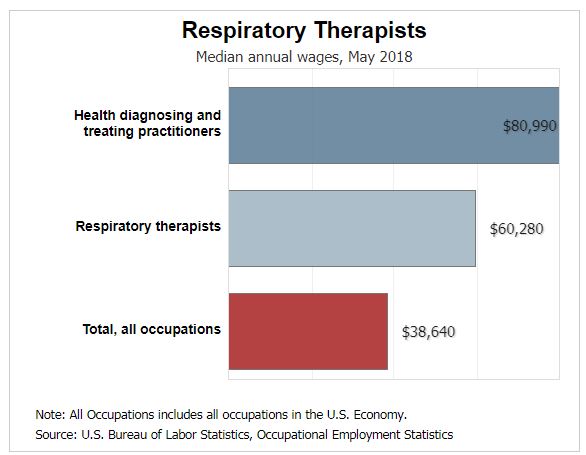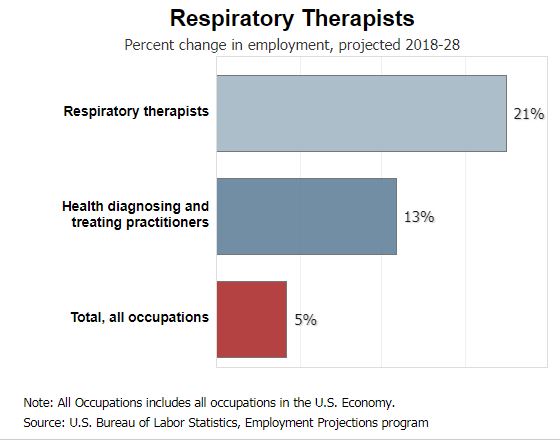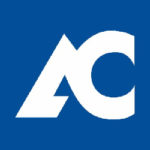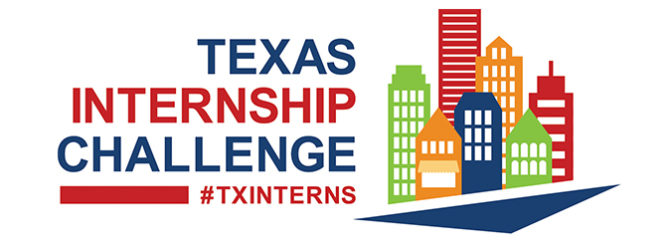Respiratory Therapist
Angela | December 17, 2019
894 Views
75 Likes
4.71
On 14 Ratings
Related
Respiratory Therapist
Respiratory therapists care for patients who have trouble breathing—for example, from a chronic respiratory disease, such as asthma or emphysema. Their patients range from premature infants with undeveloped lungs to elderly patients who have diseased lungs. They also provide emergency care to patients suffering from heart attacks, drowning, or shock.

Respiratory therapists typically do the following:
- Interview and examine patients with breathing or cardiopulmonary disorders
- Consult with physicians to develop patient treatment plans
- Perform diagnostic tests, such as measuring lung capacity
- Treat patients by using a variety of methods, including chest physiotherapy and aerosol medications
- Monitor and record patients’ progress
- Teach patients how to take medications and use equipment, such as ventilators
Respiratory therapists use various tests to evaluate patients. For example, therapists test lung capacity by having patients breathe into an instrument that measures the volume and flow of oxygen when they inhale and exhale. Respiratory therapists also may take blood samples and use a blood gas analyzer to test oxygen and carbon dioxide levels.
Respiratory therapists perform chest physiotherapy on patients to remove mucus from their lungs and make it easier for them to breathe. Removing mucus is necessary for patients suffering from lung diseases, such as cystic fibrosis, and involves the therapist vibrating the patient’s rib cage, often by tapping the patient’s chest and encouraging him or her to cough.
Respiratory therapists may connect patients who cannot breathe on their own to ventilators that deliver oxygen to the lungs. Therapists insert a tube in the patient’s windpipe (trachea) and connect the tube to ventilator equipment. They set up and monitor the equipment to ensure that the patient is receiving the correct amount of oxygen at the correct rate.
Respiratory therapists who work in home care teach patients and their families to use ventilators and other life-support systems in their homes. During these visits, they may inspect and clean equipment, check the home for environmental hazards, and ensure that patients know how to use their medications. Therapists also make emergency home visits when necessary.
In some hospitals, respiratory therapists are involved in related areas, such as diagnosing breathing problems for people with sleep apnea and counseling people on how to stop smoking.
Respiratory therapists held about 134,000 jobs in 2018. The largest employers of respiratory therapists were as follows:
| Hospitals; state, local, and private | 81% |
| Nursing care facilities (skilled nursing facilities) | 5 |
| Offices of physicians | 2 |
Respiratory therapists are on their feet for long periods and may need to lift or turn disabled patients. Therapists work closely with registered nurses, physicians and surgeons, and medical assistants.
Work Schedules
Most respiratory therapists work full time. Because they may work in medical facilities, such as hospitals that are always open, some may work evening, night, or weekend hours.
Respiratory therapists typically need an associate’s degree, but some have bachelor’s degrees in respiratory therapy. Respiratory therapists are licensed in all states except Alaska; requirements vary by state.
Education
Respiratory therapists need at least an associate’s degree, but employers may prefer applicants who have a bachelor’s degree. Educational programs are offered by colleges and universities, vocational–technical institutes, and the Armed Forces. Completion of a program that is accredited by the Commission on Accreditation for Respiratory Care may be required for licensure.
Respiratory therapy programs typically include courses in human anatomy and physiology, chemistry, physics, microbiology, pharmacology, and math. Other courses deal with therapeutic and diagnostic procedures and tests, equipment, patient assessment, and cardiopulmonary resuscitation (CPR). In addition to coursework, programs have clinical components that allow students to gain supervised, practical experience in treating patients.
High school students interested in applying to respiratory therapy programs should take courses in health, biology, math, chemistry, and physics.
Licenses, Certifications, and Registrations
Respiratory therapists are licensed in all states except Alaska, where national certification is recommended, although not required. Licensure requirements vary by state; for most states they include passing a state or professional certification exam. For specific state requirements, contact the state’s health board.
The National Board for Respiratory Care (NBRC) is the main certifying body for respiratory therapists. The Board offers two levels of certification: Certified Respiratory Therapist (CRT) and Registered Respiratory Therapist (RRT).
Important Qualities
Compassion. Respiratory therapists should be able to provide emotional support to patients undergoing treatment and be sympathetic to their needs.
Detail oriented. Respiratory therapists must be detail oriented to ensure that patients are receiving the appropriate treatments and medications in a timely manner. They must also monitor and record various pieces of information related to patient care.
Interpersonal skills. Respiratory therapists interact with patients and often work as part of a team. They must be able to follow instructions from a supervising physician.
Patience. Respiratory therapists may work for long periods with patients who need special attention.
Problem-solving skills. Respiratory therapists need strong problem-solving skills. They must evaluate patients’ symptoms, consult with other healthcare professionals, and recommend and administer the appropriate treatments.
Science and math skills. Respiratory therapists must understand anatomy, physiology, and other sciences and be able to calculate the right dose of a patient’s medicine.
The median annual wage for respiratory therapists was $60,280 in May 2018. The median wage is the wage at which half the workers in an occupation earned more than that amount and half earned less. The lowest 10 percent earned less than $43,750, and the highest 10 percent earned more than $83,520.
In May 2018, the median annual wages for respiratory therapists in the top industries in which they worked were as follows:
| Hospitals; state, local, and private | $60,500 |
| Offices of physicians | 60,300 |
| Nursing care facilities (skilled nursing facilities) | 60,260 |
Most respiratory therapists work full time. Because they may work in medical facilities, such as hospitals that are always open, some therapists work evening, night, or weekend hours.
 Employment of respiratory therapists is projected to grow 21 percent from 2018 to 2028, much faster than the average for all occupations. Growth in the middle-aged and older population will lead to an increased incidence of respiratory conditions such as pneumonia, chronic obstructive pulmonary disease (COPD), and other disorders that can permanently damage the lungs or restrict lung function. The aging population will in turn lead to an increased demand for respiratory therapy services and treatments, mostly in hospitals.
Employment of respiratory therapists is projected to grow 21 percent from 2018 to 2028, much faster than the average for all occupations. Growth in the middle-aged and older population will lead to an increased incidence of respiratory conditions such as pneumonia, chronic obstructive pulmonary disease (COPD), and other disorders that can permanently damage the lungs or restrict lung function. The aging population will in turn lead to an increased demand for respiratory therapy services and treatments, mostly in hospitals.
In addition, a growing emphasis on reducing readmissions in hospitals may result in more demand for respiratory therapists in nursing homes and in doctors’ offices.
Advances in preventing and detecting disease, improved medications, and more sophisticated treatments will also increase the demand for respiratory therapists. Other conditions affecting the general population, such as respiratory problems due to smoking and air pollution, along with respiratory emergencies, will continue to create demand for respiratory therapists.
Job Prospects
Job prospects will be best for therapists willing to travel to look for job opportunities. Some areas will be saturated with workers, and other areas (more often, rural areas) will be in need of respiratory therapists’ services. Certification is generally recommended, as it may increase an applicant’s competitiveness in the job market.
Bureau of Labor Statistics, U.S. Department of Labor, Occupational Outlook Handbook, Respiratory Therapists,
on the Internet at https://www.bls.gov/ooh/healthcare/respiratory-therapists.htm (visited December 13, 2019).
Salary information comes from the Bureau of Labor Statistics, Occupational Employment Statistics Program, a semi-annual survey that provides wage and employment statistics for the nation, each state, and sub-state regions.
Tagged as AC, Amarillo College, Career, Clarendon College, Education, Frank Phillips College, Healthcare, Hometown Success, Jobs Ya'll, Medical Field, Occupation, Ochiltree General Hospital, Perryton, Pharmacology, Region 16, Respiratory Therapist, Rural Community, Texas, Texas Panhandle, Texas Tech University, Texas Workforce Commission, West Texas A&M University, Workforce Solutions Panhandle.
Written by Angela










